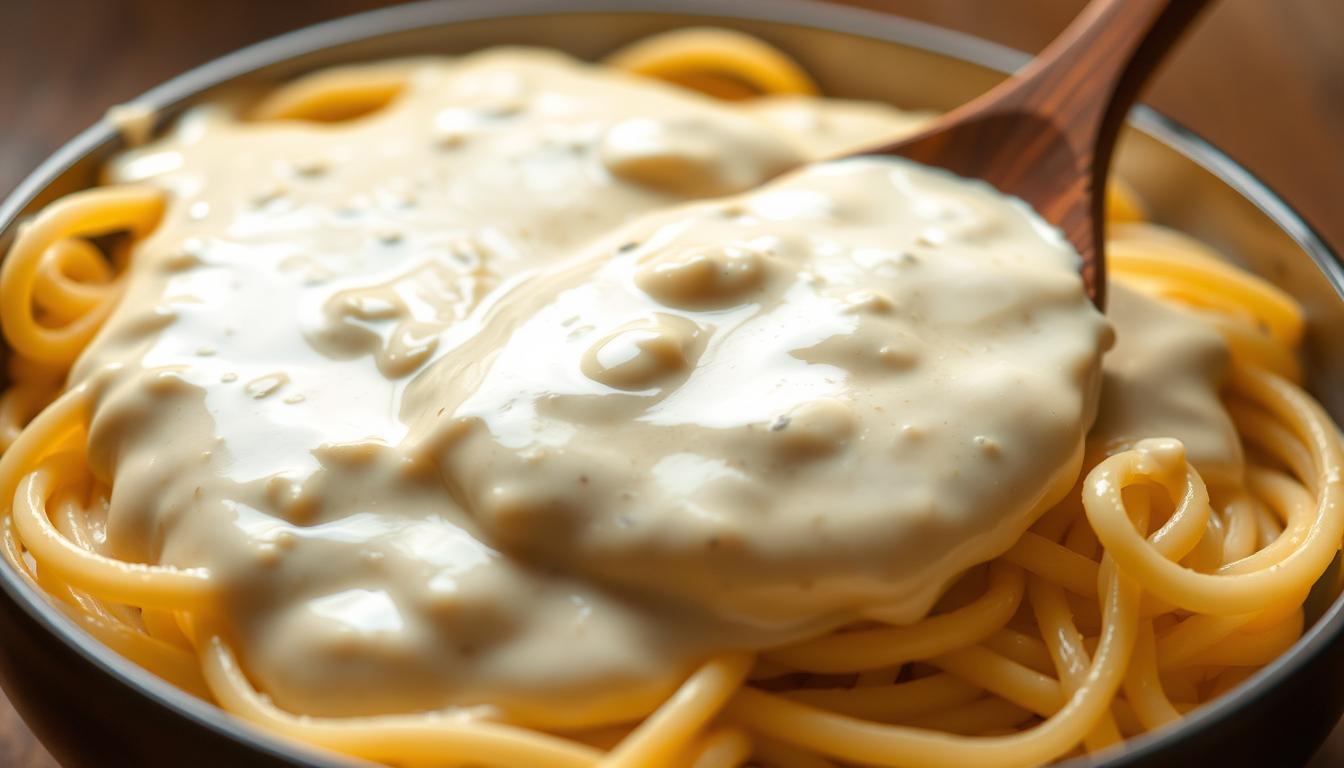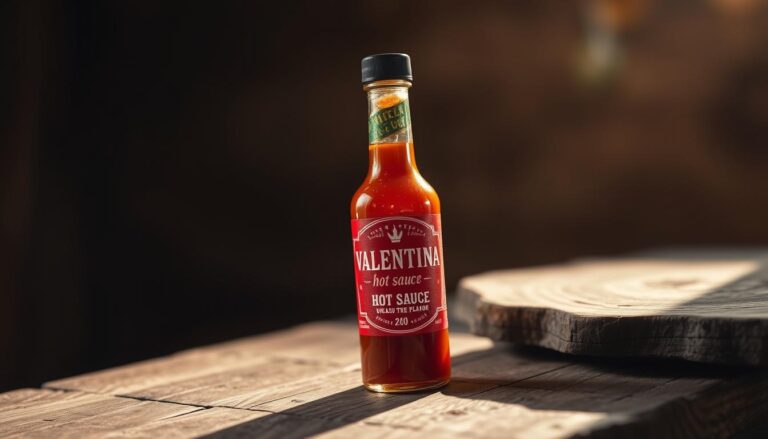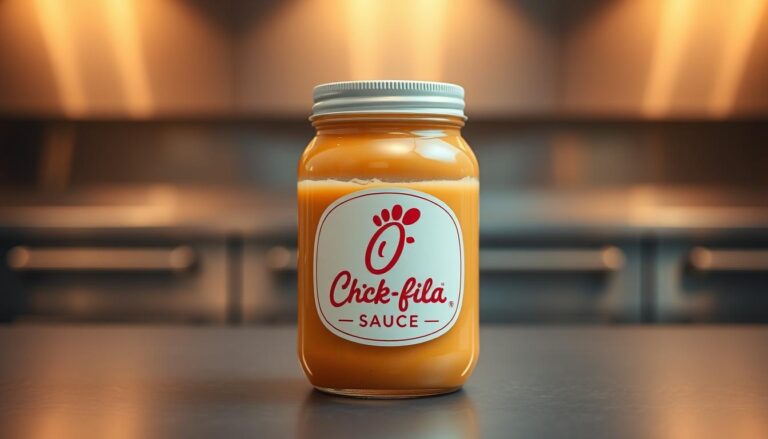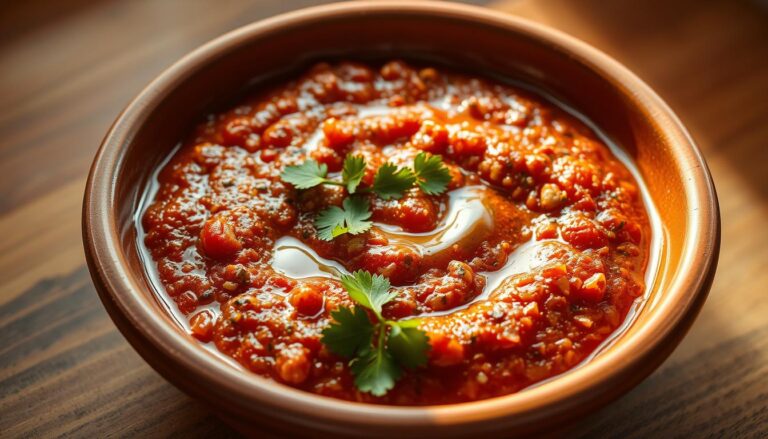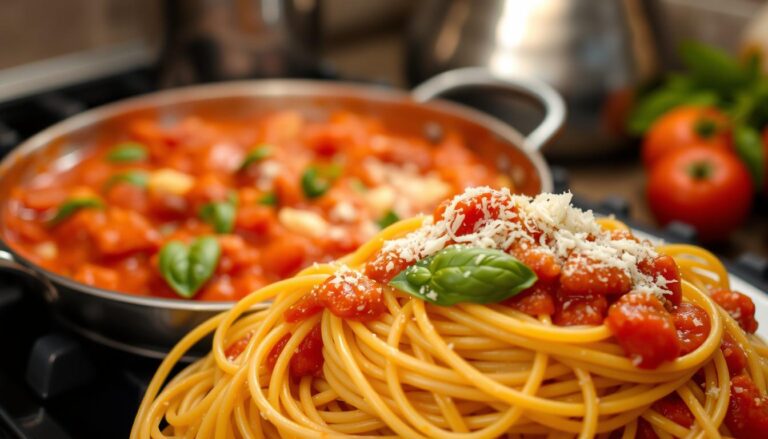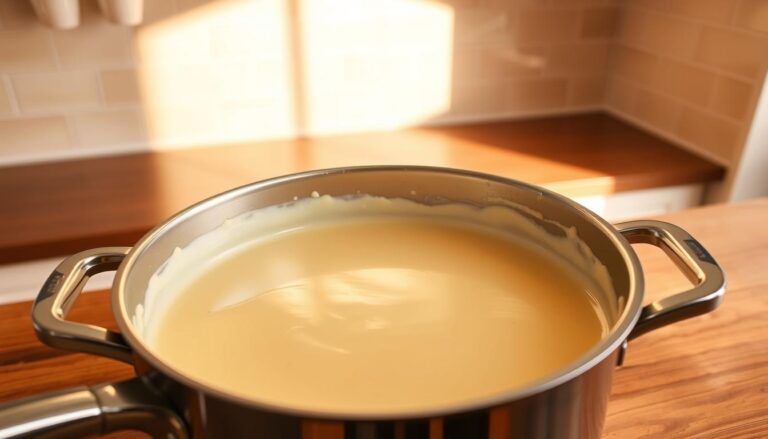Homemade Alfredo Sauce: A Delicious Classic
Making homemade alfredo sauce from scratch is a game-changer for any pasta lover. This rich and creamy Italian classic is surprisingly easy to prepare, and the flavor is far superior to store-bought versions.
By using just a few high-quality ingredients, you can create a delicious and authentic Italian recipe that will elevate your pasta dishes to a new level.
Key Takeaways
- Learn how to make a rich and creamy homemade alfredo sauce
- Discover the benefits of making alfredo sauce from scratch
- Explore the simplicity of creating an authentic Italian recipe
- Elevate your pasta dishes with a delicious homemade sauce
- Impress your family and friends with your culinary skills
The Rich History of Alfredo Sauce
Alfredo sauce, known for its creamy texture, has a fascinating history that began in Rome. This beloved sauce was first created by Italian chef Alfredo Di Lelio in the early 20th century. Originally called “Fettuccine al Burro,” it was made with just a few ingredients: fettuccine pasta, butter, and Parmesan cheese.
Origins in Rome
The sauce originated in Rome as a simple yet rich dish. Di Lelio’s creation was initially intended to please his wife, who was recovering from childbirth. The dish quickly gained popularity among locals and visitors alike, becoming a staple of Italian cuisine.
Evolution in American Cuisine
As Italian immigrants traveled to the United States, they brought their culinary traditions with them. Alfredo sauce gained widespread popularity in America, where it was often modified with additional ingredients like heavy cream to enhance its richness.
Why It Remains a Favorite
Today, Alfredo sauce remains a favorite among pasta lovers worldwide. Its enduring popularity can be attributed to its rich flavor and versatility. Whether served with fettuccine, chicken, or vegetables, Alfredo sauce continues to be a beloved component of many meals.
| Year | Event | Location |
|---|---|---|
| 1908 | Alfredo Di Lelio creates Fettuccine al Burro | Rome, Italy |
| 1920s | Alfredo sauce gains popularity among locals and visitors | Rome, Italy |
| 1950s | Italian immigrants introduce Alfredo sauce to America | United States |
Why Homemade Alfredo Sauce Beats Store-Bought
While store-bought Alfredo sauce is convenient, homemade sauce provides a richer culinary experience. Making Alfredo sauce from scratch allows for a depth of flavor and quality that is hard to match with commercial products.
Flavor Comparison
The flavor of homemade Alfredo sauce is distinctly richer and more complex compared to store-bought versions. Freshly grated Parmesan cheese and high-quality butter make a significant difference in the taste. Store-bought sauces often lack the freshness and can have a preservative aftertaste.
Control Over Ingredients
When you make Alfredo sauce at home, you have complete control over the ingredients. This means you can choose high-quality dairy products and adjust the amount of garlic and seasoning to your liking. It’s also a great way to avoid preservatives and additives found in many commercial sauces.
Cost Effectiveness
Making Alfredo sauce at home can be more cost-effective in the long run. Although the initial investment in ingredients might seem higher, you can make larger batches and store them for later use. This reduces the cost per serving compared to buying individual jars or packets of store-bought sauce.
Customization Options
Homemade Alfredo sauce offers endless customization options. You can adjust the sauce to suit your dietary needs or preferences, such as using lower-fat dairy products or adding herbs and spices for extra flavor. This flexibility is particularly useful for those with specific dietary requirements or taste preferences.
In conclusion, while store-bought Alfredo sauce has its convenience, the benefits of homemade Alfredo sauce make it a worthwhile choice for those seeking a richer, more personalized culinary experience.
Essential Ingredients for the Perfect Alfredo Sauce
Crafting the perfect Alfredo sauce starts with selecting the finest ingredients. The quality of your Alfredo sauce is directly related to the quality of its components.
Choosing the Right Cheese
The type of cheese used in Alfredo sauce is crucial. Parmesan cheese is the traditional choice, but some recipes also include Romano cheese.
Parmesan vs. Romano
While both cheeses are sharp and salty, Parmesan has a nuttier flavor that works well in Alfredo sauce. Romano, on the other hand, has a more pronounced saltiness.
Pre-grated vs. Freshly Grated
Freshly grated Parmesan cheese is preferred over pre-grated because it melts better and has a more vibrant flavor.
Butter Quality Matters
High-quality butter is essential for a rich and creamy Alfredo sauce. European-style butter is a good choice due to its higher fat content.
Heavy Cream vs. Half-and-Half
Both heavy cream and half-and-half can be used to enrich Alfredo sauce. Half-and-half provides a richer texture, while heavy cream offers a lighter consistency.
| Ingredient | Heavy Cream | Half-and-Half |
|---|---|---|
| Fat Content | 36% | 50% |
| Texture | Light | Rich |
Garlic and Seasonings
Garlic is a fundamental flavor component in Alfredo sauce. Use fresh garlic for the best flavor. Seasonings such as salt, pepper, and nutmeg can be added to taste.
Kitchen Tools You’ll Need
Having the proper cooking utensils is crucial for preparing authentic Alfredo sauce. To get started, you’ll need a few essential tools that will make the cooking process smoother and more efficient.
Pots and Pans
A good quality saucepan is vital for making Alfredo sauce. Look for a pan that’s heavy-bottomed and made of a material that distributes heat evenly, such as stainless steel or copper. This will help prevent the sauce from burning or sticking to the pan.
Whisks and Spatulas
A wire whisk is necessary for smoothly combining the sauce ingredients. You’ll also need a silicone spatula for scraping the sides of the pan and folding ingredients together gently.
Measuring Equipment
Accurate measurements are key to a successful Alfredo sauce. Use a digital kitchen scale or measuring cups to ensure you’re adding the right amounts of each ingredient.
Classic Alfredo Sauce Recipe
With just a few ingredients, you can create a deliciously authentic Alfredo sauce that’s sure to become a staple in your kitchen.
Ingredient List
To make a classic Alfredo sauce, you’ll need the following ingredients:
- 1/2 cup (1 stick) unsalted butter
- 3 cloves garlic, minced
- 1 cup heavy cream
- 1/2 cup grated Parmesan cheese (freshly shredded is best)
- Salt and black pepper, to taste
Preparation Steps
Before you start cooking, make sure you have all your ingredients ready. Freshly grate your Parmesan cheese for the best flavor, and soften your butter to ensure it melts smoothly.
Cooking Instructions
Cooking your Alfredo sauce requires attention to temperature and timing. Here’s how to do it:
Temperature Control
Keep your heat on medium-low to prevent the sauce from boiling. You want it to simmer gently.
Timing Guidelines
Cook your sauce for about 5-7 minutes, stirring constantly, until it thickens and coats the back of a spoon.
Once your sauce is cooked, remove it from the heat and immediately toss it with your cooked pasta. This ensures the sauce clings to the pasta rather than pooling on the plate.
Visual Cues for Doneness
A well-made Alfredo sauce should be creamy and smooth, coating the pasta evenly. If it’s too thick, you can thin it with a little more heavy cream. If it’s too thin, simmer it for a few more minutes.
Making Alfredo sauce from scratch is a simple process that yields a rich, creamy, and deliciously garlicky sauce perfect for any pasta dish.
Common Mistakes to Avoid When Making Alfredo Sauce
Making Alfredo sauce can be a simple yet nuanced process. The key to a perfect Alfredo sauce lies in avoiding a few critical mistakes that can turn this creamy, rich dish into a culinary disaster.
Temperature Control Issues
One of the most common mistakes is failing to control the temperature properly. Heating the sauce too high can cause it to break or separate, leading to an unappetizing texture. It’s crucial to heat the sauce over low heat and stir constantly.
Cheese Selection Errors
Using the wrong type of cheese or pre-shredded cheese can significantly affect the flavor and texture. Parmesan cheese is traditional, but using low-quality or aged Parmesan can alter the taste. Grating your own cheese is recommended for the best results.
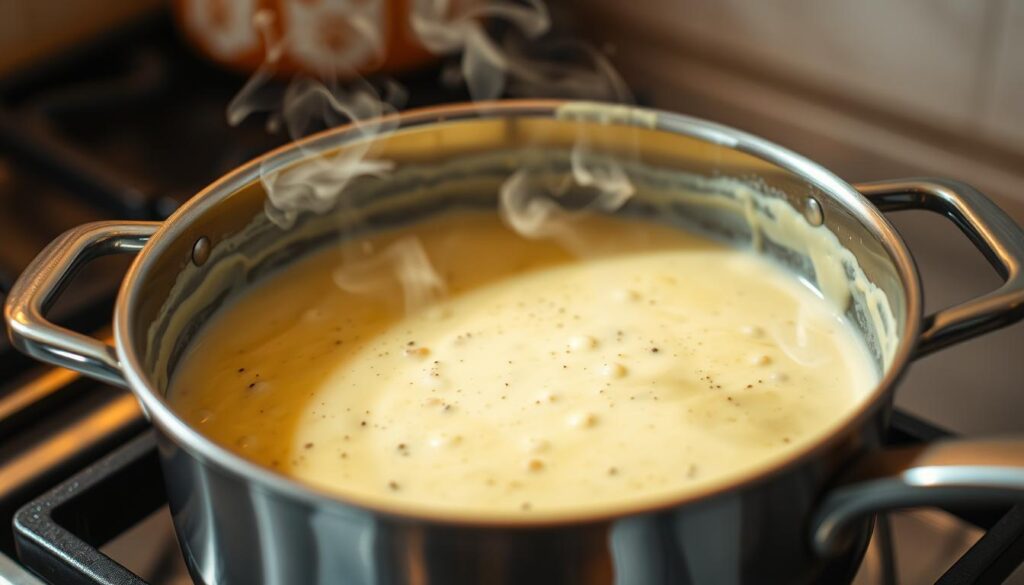
Timing Problems
Timing is everything when making Alfredo sauce. Overcooking can result in a thick, glue-like consistency, while undercooking might leave it too runny. The sauce should be cooked just until it coats the back of a spoon.
Ingredient Substitution Pitfalls
Substituting ingredients might seem harmless, but it can drastically change the character of the Alfredo sauce. For instance, using low-fat cream or milk instead of heavy cream can result in a less rich sauce.
| Common Mistake | Result | Solution |
|---|---|---|
| High heat | Broken sauce | Use low heat, stir constantly |
| Pre-shredded cheese | Poor texture | Grate your own cheese |
| Overcooking | Thick, glue-like consistency | Cook until it coats the back of a spoon |
By being aware of these common mistakes and taking steps to avoid them, you can create a delicious, authentic Alfredo sauce that will elevate your pasta dishes.
Healthier Alfredo Sauce Variations
You don’t have to sacrifice taste for nutrition; discover how to create a healthier Alfredo sauce that still satisfies your pasta cravings. Making a few simple adjustments to the traditional recipe can significantly enhance its nutritional profile.
Lower-Fat Options
Reducing the fat content in Alfredo sauce can be achieved through clever substitutions. One effective method is to replace high-fat ingredients with lower-fat alternatives.
Greek Yogurt Substitutions
Replacing heavy cream with Greek yogurt is an excellent way to cut down on fat while maintaining creaminess. Greek yogurt adds a tangy flavor and a boost of protein.
Light Cream Alternatives
Using light cream or half-and-half can also reduce the fat content without sacrificing too much of the rich flavor. These alternatives still provide a creamy texture but with fewer calories.
Dairy-Free Alternatives
For those with dairy intolerance or preferences, there are several dairy-free alternatives that can be used in place of traditional dairy products. Options include almond milk, soy milk, and coconut cream.
Adding Vegetables for Nutrition
Incorporating steamed vegetables like broccoli or spinach into your Alfredo sauce can boost its nutritional value. These vegetables add fiber, vitamins, and antioxidants.
Portion Control Tips
Even with healthier versions, controlling portion sizes is key to maintaining a balanced diet. Be mindful of the amount of sauce you’re using and try to balance it with other nutrient-dense foods.
| Healthier Option | Description | Nutritional Benefit |
|---|---|---|
| Greek Yogurt | Replaces heavy cream for a creamier texture | Higher protein, lower fat |
| Light Cream | Used instead of heavy cream | Reduced fat content |
| Vegetable Additions | Steamed broccoli or spinach added to sauce | Increased vitamins and fiber |
By implementing these healthier Alfredo sauce variations, you can enjoy your favorite dish while keeping your diet on track.
Flavor Variations to Enhance Your Alfredo Sauce Recipe
Transform your Alfredo sauce into a culinary masterpiece with these innovative ideas. While the classic recipe is a staple, experimenting with different flavors can elevate your pasta dishes to new heights.
Herb-Infused Alfredo
Adding herbs to your Alfredo sauce can introduce a fresh and aromatic dimension. Fresh or dried herbs can be used, each offering unique benefits.
Fresh vs. Dried Herbs
Fresh herbs like parsley and basil provide a vibrant flavor, while dried herbs such as thyme and oregano offer a more concentrated taste. The choice between fresh and dried depends on personal preference and the desired intensity.
Herb Combinations
Combining herbs can create complex and intriguing flavors. For example, pairing basil with parsley or thyme with rosemary can add depth to your Alfredo sauce.
Spicy Alfredo Options
For those who enjoy a bit of heat, adding spicy elements to Alfredo sauce can be a game-changer. Consider incorporating red pepper flakes or diced jalapeños to give your sauce a spicy kick.
Seafood Additions
Seafood can enhance the richness of Alfredo sauce. Shrimp, scallops, or even lobster can be added to create a decadent and satisfying dish.
Truffle and Mushroom Infusions
Truffles and mushrooms can add an earthy, luxurious flavor to Alfredo sauce. Truffle oil or shaved truffles, along with sautéed mushrooms, can elevate the sauce to a gourmet level.
| Variation | Key Ingredients | Flavor Profile |
|---|---|---|
| Herb-Infused | Fresh or dried herbs | Fresh, aromatic |
| Spicy | Red pepper flakes, jalapeños | Spicy, bold |
| Seafood | Shrimp, scallops, lobster | Rich, savory |
| Truffle and Mushroom | Truffle oil, mushrooms | Earthy, luxurious |
Perfect Pairings: What to Serve with Alfredo Sauce
The key to a memorable Italian meal lies in the perfect pairings with Alfredo sauce. To create a well-rounded dining experience, it’s essential to choose the right accompaniments.
Pasta Varieties That Work Best
Alfredo sauce is traditionally paired with fettuccine, but other pasta varieties can also complement it well. Fettuccine remains the classic choice due to its flat shape that holds the creamy sauce effectively. However, linguine and pappardelle are also excellent options for those looking to mix things up.
Protein Additions
Adding protein can enhance the flavor and nutritional value of your meal. Here are some popular choices:
Chicken Preparations
Grilled or sautéed chicken can be added on top of the pasta for a hearty meal. Chicken breast is a lean option that pairs well with Alfredo sauce.
Seafood Options
For seafood lovers, shrimp and scallops are excellent choices. They can be sautéed in garlic butter before being tossed with the pasta and Alfredo sauce.
| Protein | Preparation Method | Flavor Profile |
|---|---|---|
| Chicken Breast | Grilled or Sautéed | Lean and Savory |
| Shrimp | Sautéed in Garlic Butter | Rich and Briny |
| Scallops | Pan-Seared | Tender and Sweet |
Complementary Side Dishes
A simple green salad or roasted vegetables can provide a nice contrast to the richness of Alfredo sauce. Consider serving steamed asparagus or a mixed greens salad with a light vinaigrette.
Wine Pairing Suggestions
For a sophisticated dining experience, a dry white wine such as Pinot Grigio or Chardonnay pairs well with Alfredo sauce. The crisp acidity helps cut through the creaminess of the sauce.
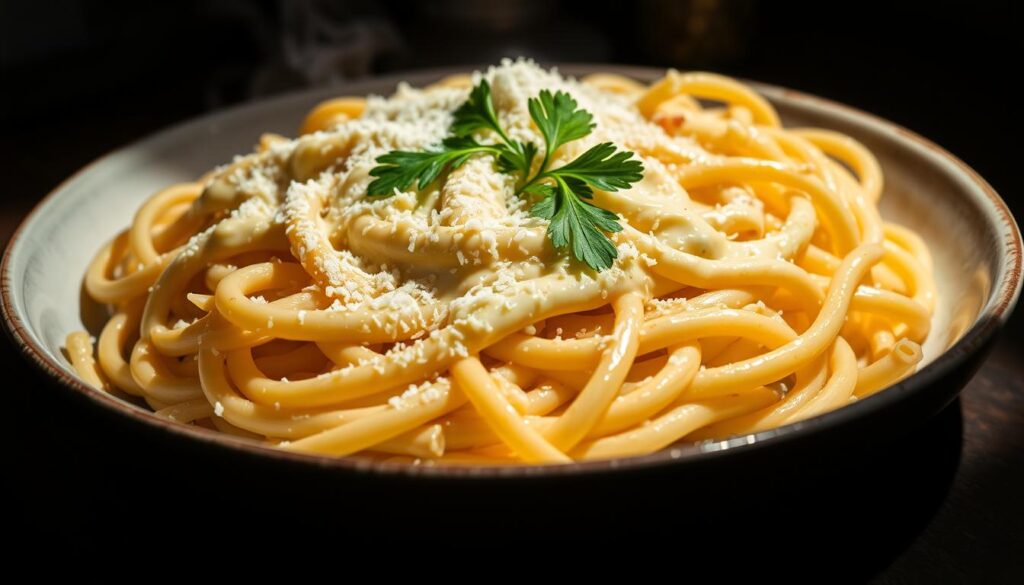
By thoughtfully selecting your pasta, protein, side dishes, and wine, you can create a truly memorable meal centered around Alfredo sauce.
Storing and Reheating Your Homemade Alfredo Sauce
Properly storing your homemade Alfredo sauce is crucial for maintaining its rich flavor and creamy texture. Whether you’re dealing with leftovers or preparing the sauce in advance, understanding the best storage and reheating methods will ensure your Alfredo sauce remains delicious.
Refrigeration Guidelines
Store your Alfredo sauce in an airtight container in the refrigerator. It can last for up to 3 to 5 days when stored properly. Make sure to label the container with the date to keep track of how long it’s been stored.
Freezing Techniques
For longer storage, consider freezing your Alfredo sauce. Pour the sauce into an airtight container or freezer bag, making sure to remove as much air as possible before sealing. Frozen Alfredo sauce can last for up to 3 months. When you’re ready to use it, simply thaw the sauce overnight in the refrigerator.
Best Reheating Methods
Reheating Alfredo sauce requires gentle heat to prevent it from breaking or becoming too thick. There are two primary methods for reheating: stovetop and microwave.
Stovetop Reheating
Place the sauce in a saucepan over low heat, stirring constantly until it’s warmed through. This method allows for better control over the temperature.
Microwave Tips
Transfer the sauce to a microwave-safe bowl and heat it in short intervals (20-30 seconds), stirring between each interval until the sauce is heated through.
Reviving Separated Sauce
If your Alfredo sauce has separated during storage or reheating, don’t worry. Simply whisk in a little heavy cream or milk, and gently heat the sauce while stirring constantly until it’s smooth again.
| Storage Method | Duration | Reheating Tips |
|---|---|---|
| Refrigeration | 3-5 days | Stir well before reheating |
| Freezing | Up to 3 months | Thaw overnight in the refrigerator |
Troubleshooting Your Alfredo Sauce
Common issues with Alfredo sauce can be easily resolved with a few simple techniques. Whether your sauce has broken, is too thick, or has become over-seasoned, there are practical solutions to these common problems.
Fixing a Broken Sauce
A broken Alfredo sauce can be revived by slowly whisking in a little more heavy cream or warm water. This helps to re-emulsify the sauce, restoring its smooth texture.
Adjusting Thickness
If your Alfredo sauce is too thick, you can thin it out with a bit of pasta water or additional heavy cream. Conversely, if it’s too thin, simmering it gently or adding more Parmesan cheese can help thicken it.
Salvaging Over-Seasoned Sauce
To fix an over-seasoned Alfredo sauce, you can try adding a dairy component like more cream or butter to dilute the seasoning. Alternatively, adding more pasta or a starchy ingredient can also help balance out the flavors.
Addressing Graininess
Graininess in Alfredo sauce is often due to the cheese not melting properly. To fix this, ensure that your cheese is grated finely and that you’re stirring constantly over low heat until it’s fully incorporated.
| Issue | Solution |
|---|---|
| Broken Sauce | Whisk in heavy cream or warm water |
| Too Thick | Add pasta water or heavy cream |
| Too Thin | Simmer or add Parmesan cheese |
| Over-Seasoned | Add dairy or starchy ingredients |
| Grainy Texture | Use finely grated cheese and stir constantly |
Conclusion
Crafting homemade Alfredo sauce is a simple yet rewarding process that elevates your Italian cooking. By following the steps outlined in this article, you can create a rich, creamy sauce that’s sure to become a staple in your kitchen.
With a few basic ingredients and some essential kitchen tools, you’ll be on your way to making a delicious alfredo sauce recipe that’s tailored to your taste preferences. Whether you’re looking to impress dinner guests or simply enjoy a comforting meal, homemade Alfredo sauce is the perfect choice.
So why settle for store-bought when you can make your own homemade Alfredo sauce with ease? Give it a try and experience the difference that fresh, high-quality ingredients can make in your Italian cooking.

